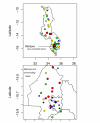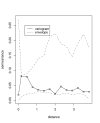Spatial analysis and mapping of malaria risk in Malawi using point-referenced prevalence of infection data
- PMID: 16987415
- PMCID: PMC1584224
- DOI: 10.1186/1476-072X-5-41
Spatial analysis and mapping of malaria risk in Malawi using point-referenced prevalence of infection data
Abstract
Background: Current malaria control initiatives aim at reducing malaria burden by half by the year 2010. Effective control requires evidence-based utilisation of resources. Characterizing spatial patterns of risk, through maps, is an important tool to guide control programmes. To this end an analysis was carried out to predict and map malaria risk in Malawi using empirical data with the aim of identifying areas where greatest effort should be focussed.
Methods: Point-referenced prevalence of infection data for children aged 1-10 years were collected from published and grey literature and geo-referenced. The model-based geostatistical methods were applied to analyze and predict malaria risk in areas where data were not observed. Topographical and climatic covariates were added in the model for risk assessment and improved prediction. A Bayesian approach was used for model fitting and prediction.
Results: Bivariate models showed a significant association of malaria risk with elevation, annual maximum temperature, rainfall and potential evapotranspiration (PET). However in the prediction model, the spatial distribution of malaria risk was associated with elevation, and marginally with maximum temperature and PET. The resulting map broadly agreed with expert opinion about the variation of risk in the country, and further showed marked variation even at local level. High risk areas were in the low-lying lake shore regions, while low risk was along the highlands in the country.
Conclusion: The map provided an initial description of the geographic variation of malaria risk in Malawi, and might help in the choice and design of interventions, which is crucial for reducing the burden of malaria in Malawi.
Figures





Similar articles
-
Folic acid supplementation and malaria susceptibility and severity among people taking antifolate antimalarial drugs in endemic areas.Cochrane Database Syst Rev. 2022 Feb 1;2(2022):CD014217. doi: 10.1002/14651858.CD014217. Cochrane Database Syst Rev. 2022. PMID: 36321557 Free PMC article.
-
Spatial modelling and risk factors of malaria incidence in northern Malawi.Acta Trop. 2007 May;102(2):126-37. doi: 10.1016/j.actatropica.2007.04.012. Epub 2007 May 4. Acta Trop. 2007. PMID: 17543264
-
Childhood malaria case incidence in Malawi between 2004 and 2017: spatio-temporal modelling of climate and non-climate factors.Malar J. 2020 Jan 6;19(1):5. doi: 10.1186/s12936-019-3097-z. Malar J. 2020. PMID: 31906963 Free PMC article.
-
Mapping malaria risk among children in Côte d'Ivoire using Bayesian geo-statistical models.Malar J. 2012 May 9;11:160. doi: 10.1186/1475-2875-11-160. Malar J. 2012. PMID: 22571469 Free PMC article.
-
Spatial and spatio-temporal methods for mapping malaria risk: a systematic review.BMJ Glob Health. 2020 Oct;5(10):e002919. doi: 10.1136/bmjgh-2020-002919. BMJ Glob Health. 2020. PMID: 33023880 Free PMC article.
Cited by
-
Characterizing the spatial and temporal variation of malaria incidence in Bangladesh, 2007.Malar J. 2012 May 21;11:170. doi: 10.1186/1475-2875-11-170. Malar J. 2012. PMID: 22607348 Free PMC article.
-
Spatial prediction of malaria prevalence in an endemic area of Bangladesh.Malar J. 2010 May 9;9:120. doi: 10.1186/1475-2875-9-120. Malar J. 2010. PMID: 20459690 Free PMC article.
-
Risk Factors Analysis of Malaria Transmission at Cross-Boundaries Area in Menoreh Hills, Java, Indonesia.Iran J Public Health. 2021 Sep;50(9):1816-1824. doi: 10.18502/ijph.v50i9.7054. Iran J Public Health. 2021. PMID: 34722377 Free PMC article.
-
Distance to Anopheles sundaicus larval habitats dominant among risk factors for parasitemia in meso-endemic Southwest Sumba, Indonesia.Pathog Glob Health. 2014 Dec;108(8):369-80. doi: 10.1179/2047773214Y.0000000167. Epub 2014 Dec 10. Pathog Glob Health. 2014. PMID: 25495283 Free PMC article.
-
Involvement of Anopheles nili in Plasmodium falciparum transmission in North Benin.Malar J. 2019 Apr 29;18(1):152. doi: 10.1186/s12936-019-2792-0. Malar J. 2019. PMID: 31036025 Free PMC article.
References
-
- WHO/UNICEF . Africa malaria report. World Health Organization/UNICEF Report series: WHO/CDS/MAL/2003; 2003. p. 1093.
-
- Government of Malawi . Malaria policy. Lilongwe: National Malaria Control Programme Community Health Sciences Unit Government of Malawi; 2002.
-
- WHO . Roll Back Malaria. Geneva: World Health Organization; 1998.
Publication types
MeSH terms
Grants and funding
LinkOut - more resources
Full Text Sources
Medical

